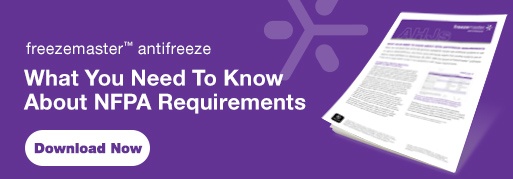
By: Mark Knurek on September 30th, 2019
Resistance to Flammability is the Key Component to UL 2901
When a fire sprinkler system activated as designed in 2009 to suppress a cooking fire – and instead intensified the blaze, killing one and injuring four – the use of antifreeze in sprinkler systems changed forever. The sprinkler system contained antifreeze that had been mixed improperly before application. A high concentration of the antifreeze agent caused the flames to virtually explode when the sprinkler system activated.
Glycerin and propylene glycol-based antifreeze solutions had been used for many years, particularly in northern climates, to keep pipes from freezing. Water-filled pipes for fire sprinkler systems, such as those made of metal or CPVC, must remain above 40° F (4.44° C) to prevent freezing that can cause severe damage, leaks or pressure drops.
The 2009 fire was not the only one in which improper antifreeze mixing added to the damage, but it was the touchpoint for industry action.
The NFPA and Underwriters Laboratories (UL) conducted extensive research, resulting in the establishment of UL 2901 in December 2013. The new standard outlines requirements for antifreeze solutions for wet pipe fire sprinkler systems. To meet these requirements, antifreeze products must prove fire performance (i.e., flammability), corrosion resistance (important for metal-based fire sprinkler systems), hydraulic characteristics, human health and environmental impact, and meet marking and installation specifications.
The establishment of UL 2901 led to changes in NFPA requirements for inspection, testing and maintenance of water-based fire protection systems. These revisions state that all traditional glycerin and propylene glycol antifreeze products may no longer be used in existing systems by September 30, 2022. These products must be replaced by a premixed listed solution by that date.
Additionally, all new antifreeze systems – with some exceptions regarding NFPA 13D and ESFR applications – must now use antifreeze solution meeting the requirements of UL 2901, which indicates the solution will not ignite when discharged from a sprinkler.
Flammability – the potential for a chemical agent to cause combustion – is a key test for antifreeze products that must meet the requirements of UL 2901.
UL 2901 and Flammability
Enabling a fire sprinkler system to operate properly by suppressing the fire that caused its activation is a must, regardless of antifreeze agents that may have been introduced into the system to prevent freezing.
UL 2901 lists three tests in regard to flammability. The first two, Exposure to Fire and Fire Fighting Effectiveness, must be passed to achieve UL 2901 certification while the third is optional.
The first test, Exposure to Fire, requires sprinklers to discharge at 8' and 20' intervals over four burners in a calorimeter room. The burners emit heptane at a rate to create a 3 megawatt fire. A sprinkler system containing only the antifreeze under test is repeatedly discharged at varying pressures and intervals. The contents emitted cannot increase the heat release by more than 40 percent over the initial 3 megawatt value.
The second test, Fire Fighting Effectiveness – Residential dwelling units, requires that antifreeze solutions must demonstrate compliance to the fire test requirements as outlined in the Fire Test Section of the Standard for Residential Sprinklers for Fire Service, UL 1626. The test employs a 16' x 16' foot room equipped with three overhead (pendant) sprinkler heads and three sidewall sprinkler heads, plus four ignition sources. The sprinklers are tested at variable rates. Tests are conducted for 10 minutes using the antifreeze solution followed by 10 minutes using water.
The third test, Fire Fighting Effectiveness – Storage, is an optional test for NFPA 13 applications for Light Hazard, Ordinary Hazard groups 1 & 2, and Storage where the intended use is over 40 gallons of antifreeze.
freezemasterTM Antifreeze Meets UL 2901 Requirements for Exposure to Fire and Fire Fighting Effectiveness
Lubrizol Advanced Materials, a specialty company with more than 30 years of fire safety expertise, has brought to market freezemasterTM antifreeze, which meets the requirements of UL 2901, “Standard for Antifreeze Solutions for Use in Fire Sprinkler Systems” – including tests for Exposure to Fire and Fire Fighting Effectiveness. UL-listed freezemasterTM antifreeze can be installed and serviced in all new and existing fire sprinkler systems for Residential, Light Hazard, Ordinary Hazard and Storage applications to help meet requirements for NFPA 13, 13R, 13D and 25, including at volumes up to 500 gallons for NFPA 13 (Light Hazard) systems. (Refer to the freezemasterTM antifreeze Installation Guide for design parameters and listing limitations.)
freezemaster™ antifreeze is precisely formulated to remain in a liquid state at temperatures as low as -12°F (-24°C) and is dyed blue for easy identification of a fully flushed and filled system, saving installers from having to constantly test a clear fluid. The new product is backed by a team of product specialists who are on call to provide onsite and technical support.
Want to know more about freezemaster™ antifreeze? Contact us today to talk with one of our product specialists.



